【Vue】12 VueRouter Part2 路由与传参
【编程式导航】
我们希望在路由跳转之前执行某一些功能。。。
<template> <div id="app"> <h2>这是App.vue组件的标题</h2> <router-link to="/home"> 首页 </router-link> <br> <router-link to="/sample" > 样本 </router-link> <br> <button @click="avent"> 事件跳转首页 </button> <router-view></router-view> </div> </template> <script> export default { name: 'App', methods : { avent() { console.log('跳转到首页'); this.$router.push("/home"); } } } </script> <style lang="stylus"> #app font-family Avenir, Helvetica, Arial, sans-serif -webkit-font-smoothing antialiased -moz-osx-font-smoothing grayscale text-align center color #2c3e50 margin-top 60px </style>
效果:

【懒加载路由】
打包之后JS文件会非常庞大,影响到页面的加载
如果我们能让不同的路由,对应的组件分割成不同的代码块
路由被访问的时候才能被加载组件,这样就高效了
路由懒加载的作用是由路由对应的组件打包成一个小的JS代码块
只有这个组件的路由被访问时才会加载JS代码块
index.js中配置:
import Vue from 'vue'; import VueRouter from "vue-router"; // 导入路由插件 //import home from "../components/home"; //import sample from "../components/sample"; const home = () => import('../components/home'); // 头部声明式 懒加载 Vue.use(VueRouter); //注入路由插件 const routes = [ { path : '/home', component : home }, { path : '/sample', component : () => import('../components/sample') } // 对象内直接声明 懒加载 ]; // 定义路由 const router = new VueRouter({ // 创建路由实例 routes, mode : 'history' }); export default router; // 导出路由实例
不知道啥问题。。。
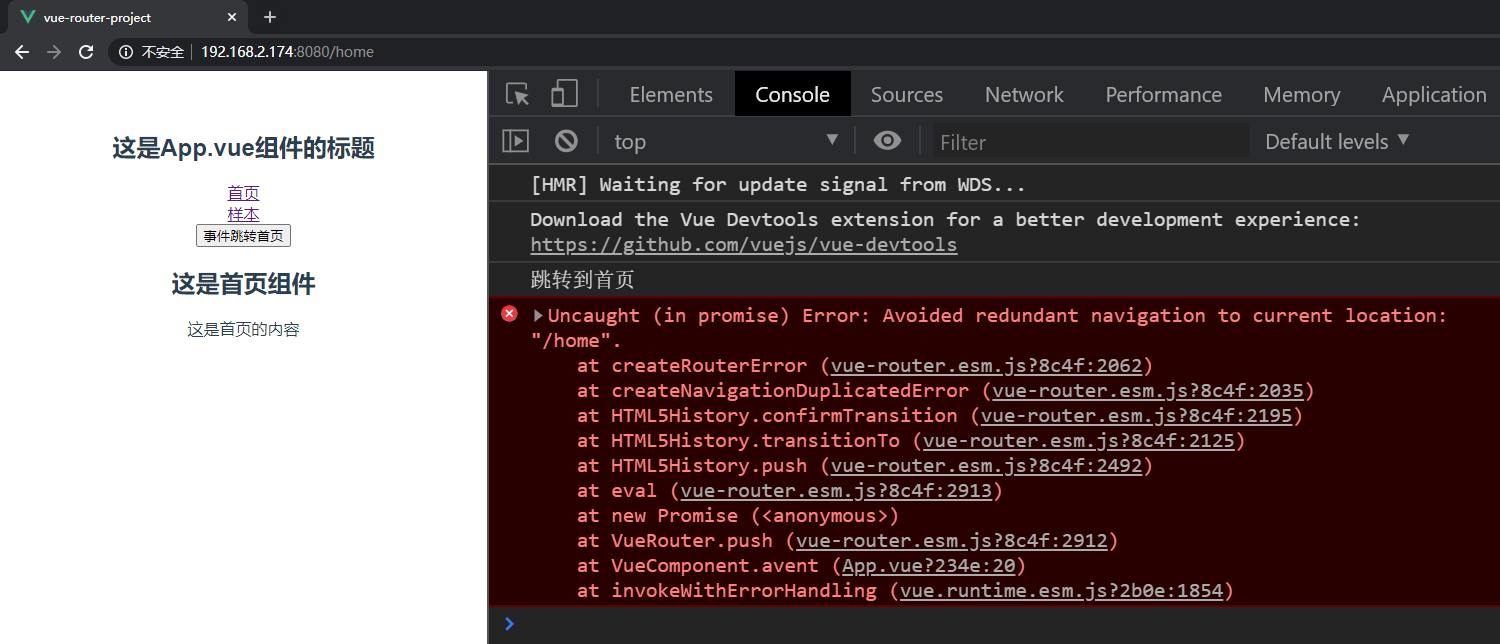
【路由嵌套】
在首页组件中又设置了两个连接路由:
<template> <div> <h2>这是首页组件</h2> <p>这是首页的内容</p> <router-link to="/news"> 新闻 </router-link> <br> <router-link to="/msg"> 消息 </router-link> </div> </template> <script> export default { name: "home" } </script> <style scoped> </style>
可以看到首页下面这两个组件:
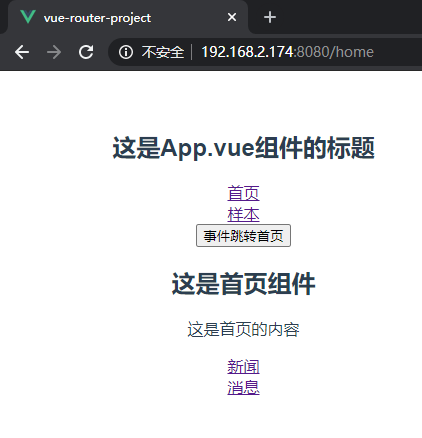
然后点击新闻发现,上一级的首页组件不能保存:

所以我们需要嵌套路由,首先
首页组件页设置view标签
其次,在indexjs种设置子组件,并放入新闻和消息组件:
import Vue from 'vue'; import VueRouter from "vue-router"; // 导入路由插件 import home from "../components/home"; import sample from "../components/sample"; import news from "../components/news"; import msg from "../components/msg"; Vue.use(VueRouter); //注入路由插件 const routes = [ { path : '/home', component : home, children : [ // 配置子路由 { path : '/news', component : news }, { path : '/msg', component : msg } ] }, { path : '/sample', component : sample }, ]; // 定义路由 const router = new VueRouter({ // 创建路由实例 routes, mode : 'history' }); export default router; // 导出路由实例
看起来问题像是解决了
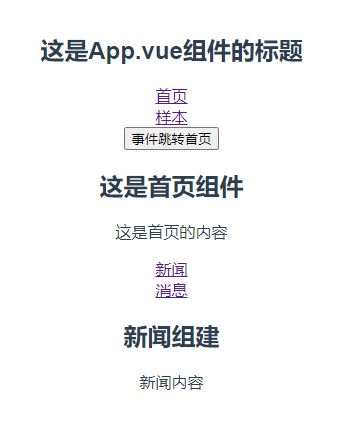
我们地址也一应该保证这样的层级关系:

index.js路由地址:
{ path : 'news', component : news },
{ path : 'msg', component : msg }
【路由传参】
路由跳转可以参数传递,参数分为两种:Params & QueryParams
【Params类型】
配置路由格式:
/new/:id
这样就表示,我们在使用新闻组件的时候需要在后面传id参数
/news/24

如果不给予参数,则组件不会显示

加上参数访问:
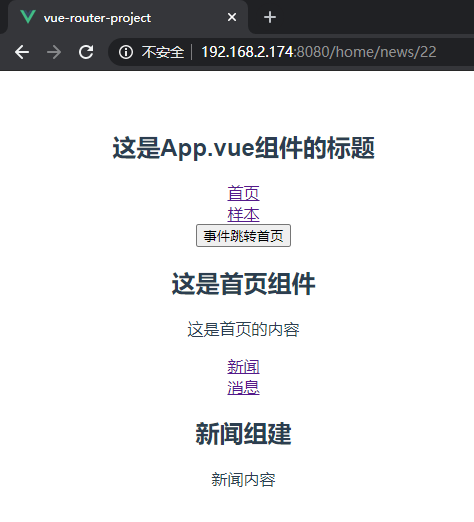
【QueryParams】
配置路由方式不变,但是采用的是原生URL参数传递

我这里没用,没有那个效果。。。
控制台也没报错。。。
【Router-Link传参】
<router-link :to="{ path : '/home/news', query : { id : 2, name : '张三', age : 23, gender : true, hobby : [1,2,3,4,5] } }" > 新闻 </router-link>
url地址渲染:
http://192.168.2.174:8080/home/news?id=2&name=%E5%BC%A0%E4%B8%89&age=23&gender=true&hobby=1&hobby=2&hobby=3&hobby=4&hobby=5
【JS代码传参】
<template> <div id="app"> <h2>这是App.vue组件的标题</h2> <router-link to="/home"> 首页 </router-link> <br> <router-link to="/sample" > 样本 </router-link> <br> <button @click="avent"> 事件跳转首页 </button> <br> <button @click="toNews"> 事件跳转home2 </button> <router-view></router-view> </div> </template> <script> export default { name: 'App', methods : { avent() { console.log('跳转到首页'); this.$router.push("/home"); }, toNews() { this.$router.push({ path : "/home/news", query : { id : 33, name : "阿伟", age : 32, gender : true, others : [1,3,5,7,9] } }); } } } </script> <style lang="stylus"> #app font-family Avenir, Helvetica, Arial, sans-serif -webkit-font-smoothing antialiased -moz-osx-font-smoothing grayscale text-align center color #2c3e50 margin-top 60px </style>
点击传递:
http://localhost:8080/home/news?id=33&name=%E9%98%BF%E4%BC%9F&age=32&gender=true&others=1&others=3&others=5&others=7&others=9
【参数获取】
在新闻组件中增加一个控制台打印查看:
<template> <div> <h2>新闻组建</h2> <p>新闻内容</p> </div> </template> <script> export default { name: "news", created() { console.log(this.$route); } } </script> <style scoped> </style>
访问测试:
这种方法必须要求:id赋值,然后才可以查询参数赋值

试试参数重复赋值时情况如何?
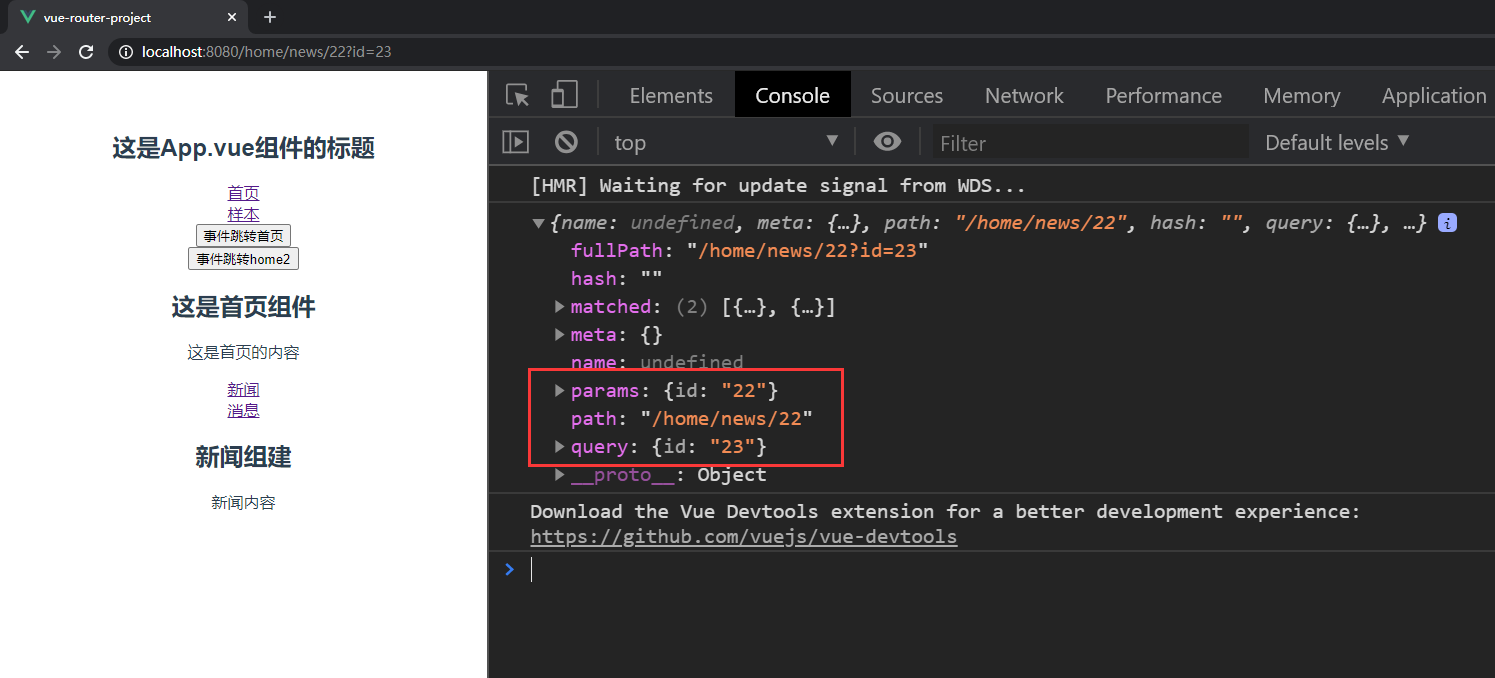
其实在这里就很明确了,params就是我们配置的格式:
改格式要求必须注入参数:RestFul风格
而query可以给也可以不给
现在打印这个参数看看:
console.log(this.$route.params.id);
效果:

【路由监听】
每次请求访问都会被获取到
<template> <div id="app"> <h2>这是App.vue组件的标题</h2> <router-link to="/home"> 首页 </router-link> <br> <router-link to="/sample" > 样本 </router-link> <br> <button @click="avent"> 事件跳转首页 </button> <br> <button @click="toNews"> 事件跳转home2 </button> <router-view></router-view> </div> </template> <script> export default { name: 'App', methods : { avent() { console.log('跳转到首页'); this.$router.push("/home"); }, toNews() { this.$router.push({ path : "/home/news", query : { id : 33, name : "阿伟", age : 32, gender : true, others : [1,3,5,7,9] } }); } }, watch : { '$route.path' : function (newVal, oldVal) { console.log(newVal); } } } </script> <style lang="stylus"> #app font-family Avenir, Helvetica, Arial, sans-serif -webkit-font-smoothing antialiased -moz-osx-font-smoothing grayscale text-align center color #2c3e50 margin-top 60px </style>
请求在这里都会被捕获到:
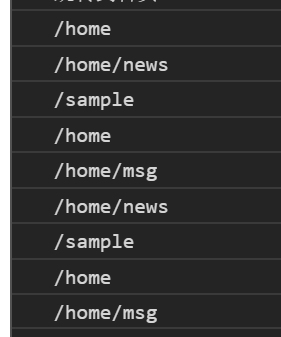
但是使用地址栏输入的方式就不会捕获
也就是说,这些都是我们在组件中使用的跳转,是由router执行的,这种方式的捕获仅限于router设置的
【$route & $router的区别?】
$router是vue-router的实例,导航到不同的URL中使用$router.push方法
$route是当前router的跳转对象,可获取name,path等等信息



